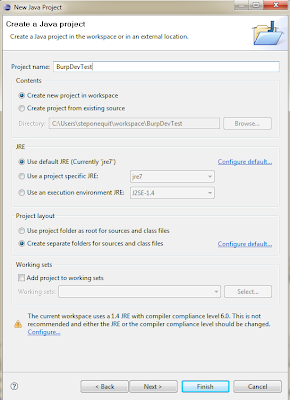For this guide you will need the following items:
- Eclipse IDE for Java Developers - http://www.eclipse.org/downloads/moreinfo/java.php
- BurpSuite Free - http://portswigger.net/burp/download.html
- Burp Extender classes - http://portswigger.net/burp/extender/
- http://portswigger.net/burp/extender/IBurpExtender.java
- http://portswigger.net/burp/extender/IBurpExtenderCallbacks.java
- http://portswigger.net/burp/extender/IHttpRequestResponse.java
- http://portswigger.net/burp/extender/IScanIssue.java
- http://portswigger.net/burp/extender/IScanQueueItem.java
- http://portswigger.net/burp/extender/IMenuItemHandler.java
After downloading and opening up Eclipse you will need to create a new java project. This can be done by clicking "File->New Java Project". Fill in a project name and click finish.
Once the project has been created you will need to create a new package called "burp". This can be done by right clicking the "src" folder under your new project and selecting "New->Package". When the dialog comes up set the "Name" as "burp":
You should now have a package named "burp" under the source folder in the right pane. Now you will need to import the Burp extender classes into your project. Download all of the extender classes to a local folder, once this is done right click on the "burp" package in your project and select "Import". On the dialog window that comes up select "General->File System" and hit "next":
On the next dialog you will need to navigate to where you downloaded the Burp extender classes to. Once you have done this you should see the classes, click on the folder to select all items and click "Finish":
Next we can add the Burp application into the project. To do this click on "Project->Properties" on the top toolbar. When the dialog opens select "Java Build Path" and then the "Libraries" tab. On this dialog click "Add External JARs..."
Navigate to where ever you have Burp downloaded to and select it. After you have done this click "OK" to dismiss the dialog. You are now ready to build your own Burp extensions. You can test your environment by creating a new class in the burp package named "BurpExtender". Right click the "burp" package and click "New->Class". On the dialog that comes up enter "BurpExtender" and click "Finish":
In the "BurpExtender" class you can enter the following:
package burp;
public class BurpExtender
{
public void registerExtenderCallbacks(IBurpExtenderCallbacks callbacks)
{
callbacks.registerMenuItem("Hello World.", new CustomMenuItem());
}
}
class CustomMenuItem implements IMenuItemHandler
{
public void menuItemClicked(String menuItemCaption, IHttpRequestResponse[] messageInfo)
{
try
{
System.out.println("Hello From Burp!");
System.out.println("Request Item Details");
System.out.println("Host: " + messageInfo[0].getHost());
System.out.println("URL: " + messageInfo[0].getUrl());
}
catch (Exception e)
{
e.printStackTrace();
}
}
}
After adding the content to your "BurpExtender" class you are ready to run the project for the first time. Click on "Run->Run" from the menu. You should see the following dialog asking how it should run your project:
Select "Java Application" and click "Ok". Next you should receive a dialog asking which application you want to run. Select "StartBurp - burp" and click "Ok":
When you click the "Hello World." menu button you should see some information about the request in your eclipse console window:
That's it, you now have setup your working development environment for building your own Burp extensions. The javadocs for the Burp Extender interfaces are available on the Extender web page:
- http://portswigger.net/burp/extender/burp/IBurpExtender.html
- http://portswigger.net/burp/extender/burp/IBurpExtenderCallbacks.html
- http://portswigger.net/burp/extender/burp/IHttpRequestResponse.html
- http://portswigger.net/burp/extender/burp/IScanIssue.html
- http://portswigger.net/burp/extender/burp/IScanQueueItem.html
- http://portswigger.net/burp/extender/burp/IMenuItemHandler.html
More information
- Hackrf Tools
- Hack App
- Pentest Tools Open Source
- What Are Hacking Tools
- Hack Tools For Ubuntu
- Pentest Tools Kali Linux
- Pentest Tools Tcp Port Scanner
- Ethical Hacker Tools
- Underground Hacker Sites
- Usb Pentest Tools
- Hacker Tools 2020
- Hack Tools Github
- Hacking Tools Mac
- Hacker Tools List
- Pentest Tools Open Source
- Hacking Tools Free Download
- Pentest Tools For Windows
- Hack Tools For Games
- Hack Tool Apk
- Hack Tools Online
- Pentest Tools Alternative
- Pentest Tools List
- Underground Hacker Sites
- Tools Used For Hacking
- Pentest Tools Alternative
- Hack App
- Hacker Tools 2020
- Hacker Search Tools
- Hacking Tools Free Download
- Pentest Tools Website Vulnerability
- Hacking Tools
- Hacker Tools 2019
- Pentest Tools Github
- Hacking Tools For Kali Linux
- Pentest Tools Download
- Computer Hacker
- Pentest Tools Download
- Pentest Tools Bluekeep
- Pentest Box Tools Download
- Pentest Box Tools Download
- Hacker Tools Linux
- Hacking Tools For Windows Free Download
- Hacking Tools
- Game Hacking
- Hacking Tools Download
- Hacker Tools Windows
- Hacking Tools Hardware
- Nsa Hacker Tools
- Pentest Tools Review
- Kik Hack Tools
- Pentest Tools Website Vulnerability
- Hack App
- Pentest Tools Online
- Pentest Tools Bluekeep
- Free Pentest Tools For Windows
- Kik Hack Tools
- Hack Website Online Tool












No comments:
Post a Comment